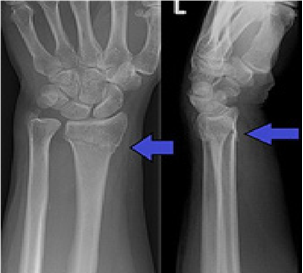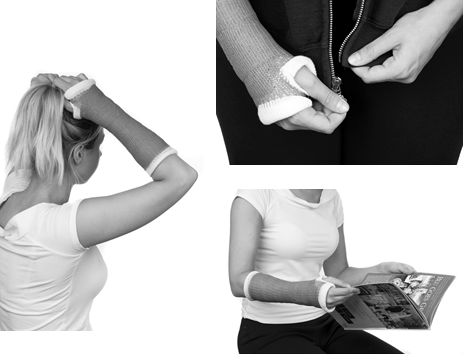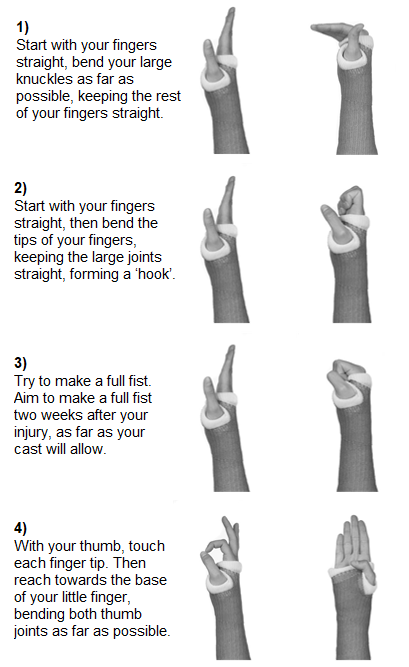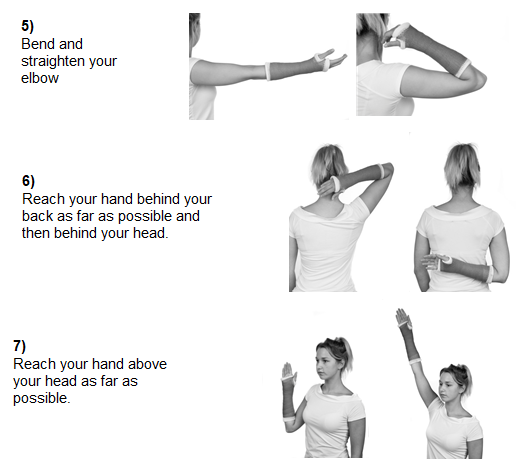Fractured wrist - In cast
What is a broken wrist?
Click here to view this as a PDF
You have sustained a fracture (break) to your wrist. This is usually in the radius bone and is called a ‘distal radius fracture’. This is located at the bottom of your forearm, just above your thumb joint. Occasionally you may also have a small chip fracture at the top of your ulna, which is the other wrist bone that sits below the line of your little finger.

Why have I been placed into a plaster?
Your broken wrist has been placed in a soft or backslab cast. The wrist is usually immobilised in a cast for 4 to 6 weeks. This helps to ensure the break heals in a good position. The cast can also help to control your pain.
Please refer to the leaflet ‘Plaster of Paris/Synthetic Cast advice for Patients and Carers’ on how to look after your cast.
Can I use my hand when I am in a cast?
During this period, it is important that you try to use your hand for light tasks (except in water) such as dressing, feeding yourself brushing hair. Use your good hand to help if necessary.

Exercises will help to prevent your fingers from becoming stiff, encourage blood supply to your soft tissues and reduce swelling, as the muscle action helps squeeze the extra fluid away from the injury. Keeping the uninjured parts moving helps speed up your recovery once the plaster has been removed and improve your function. The following exercises can be started as soon as your cast has been applied.


It might feel uncomfortable initially but with regular practice the exercises will become easier and your movement will improve. We recommend you complete the following exercises 4 times a day and repeat each exercise 5-10 times, but you can do more if you feel able to. It is advisable to take your pain killers as prescribed to enable you to complete your exercises.
Is there anything else I can do to help my recovery?
Medical evidence suggests that smoking prolongs fracture healing time. In extreme cases it can stop healing altogether. It is important that you consider this information with relation to your recent injury to optimise your recovery. For advice on smoking cessation and local support available, please refer to the following website: http://smokefree.nhs.uk or discuss this with your GP.
Do control your pain It is important that your pain is minimal to allow the uninjured parts to be kept moving and allow you to sleep well. Ask in clinic or GP for a prescription if necessary. Your pharmacist may also be able to advise you.
Do reduce the swelling. Your hand and arm may swell because of your injury which can cause pain and stiffness. Any stiffness of the unaffected joints may delay your return to work or affect your ability to perform activities of daily living. Avoid standing or sitting with your hand down by your side. A sling may be helpful in the first few days but should not be used for longer as this may result in stiffness. Swelling can be reduced by raising your arm (hand above the level of your heart), resting your arm on several pillows (especially at night) and your exercises.
Try not to ignore your injured hand. This will help to prevent muscle weakness and abnormal pain responses.
Try to eat a healthy varied diet, as poor nutrition is known to slow healing. Vitamin C 500mg daily for the first 6 weeks may help to reduce the risk of complications.
What do I do if I am having any problems?
Please refer to the leaflet ‘Plaster of Paris/Synthetic Cast advice for Patients and Carers’.
Are there any other complications?
All risks of complications can be reduced if you follow the guidance in the leaflets provided. Stiffness and reduced function are common complication in the short term, but only occasionally remains a long term problem. Persistent pain is uncommon in the long term but can occur. A very small group of patients can develop chronic pain which requires treatment with early physiotherapy. By following the advice provided, you help us to monitor you to ensure that if you are developing a rare complication we can act promptly to treat it. On very rare occasions, the tendons may not function well, or there may be increase pressure on the nerve that causes altered sensation in your thumb, index and middle fingers.
However, this can be resolved.
What happens when my cast is removed?
Your wrist fracture should be largely united (healed) 4-6 weeks after your injury, but will need another 6 weeks to become fully strong.
The cast is usually removed 4-6 weeks following your injury. You may be asked to remove this yourself. You will be provided with verbal and written instruction on how to remove the cast.
Out the cast? Look here for further information.
If you have any concerns, please contact Fracture Clinic (Neath Port Talbot Hospital) on 01639 507331
Adapted from The Royal College of Physicians (2018). Complex Regional Pain
Syndrome: UK Guidelines for diagnosis, referral and management in primary and secondary care with reference to Appendix 7 ‘ Post-fracture/operation patient information leaflet by The Royal Liverpool Hospital, p51-54.
Pease note: We are in the process of updating our website. The Welsh language is important to us and we are currently translating our content. Thank you for your patience. Ry'n ni'n y broses o ddiweddaru ein gwefan. Mae'r Gymraeg yn bwysig i ni ac ry'n ni wrthi ar hyn o bryd yn cyfieithu ein cynnwys. Diolch i chi am fod yn amyneddgar.
Rydym yn croesawu gohebiaeth a galwadau ffôn yn y Gymraeg neu'r Saesneg. Atebir gohebiaeth Gymraeg yn y Gymraeg, ac ni fydd hyn yn arwain at oedi. Mae’r dudalen hon ar gael yn Gymraeg drwy bwyso’r botwm ar y dde ar frig y dudalen.
We welcome correspondence and telephone calls in Welsh or English. Welsh language correspondence will be replied to in Welsh, and this will not lead to a delay. This page is available in Welsh by clicking ‘Cymraeg’ at the top right of this page.